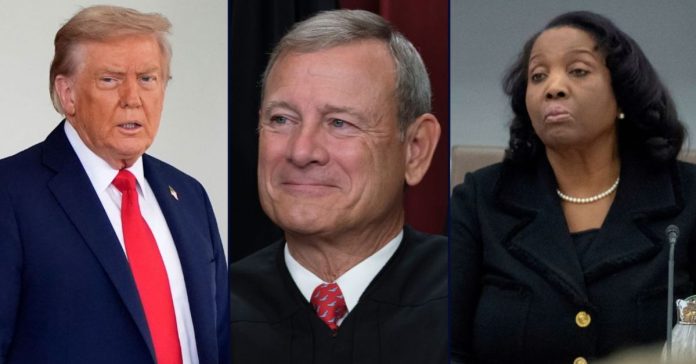
Left: President Donald Trump stands outside the White House, Monday, Aug. 18, 2025, in Washington. (AP Photo/Alex Brandon). Center: Chief Justice of the United States John Roberts joins other members of the Supreme Court as they pose for a new group portrait, at the Supreme Court building in Washington, Oct. 7, 2022 (AP Photo/J. Scott Applewhite, File). Right: Board of Governors member Lisa Cook, right, listens during an open meeting of the Board of Governors at the Federal Reserve, June 25, 2025, in Washington. (AP Photo/Mark Schiefelbein, File).
Just five days after the U.S. Court of Appeals for the D.C. Circuit reinstated a fired FTC commissioner, noting that a 90-year-old Supreme Court precedent stood in President Donald Trump’s way, Chief Justice John Roberts on Monday put that precedent on the brink in an emergency docket ruling, with potential ramifications for Lisa Cook as she aims to fend off her firing from the Federal Reserve Board of Governors.
Last week, as a veteran federal district judge expressed surprise that the high court’s rulings on the so-called “shadow docket” — or “interim docket,” as Justice Brett Kavanaugh would less sensationally call it — were binding precedent, several lower court jurists aired grievances in a news story and urged SCOTUS to be clearer when it issues emergency orders.
On Monday, Roberts followed up by offering no explanation as he granted Trump’s application for an administrative stay of a lower court ruling that concluded FTC commissioner Rebecca Kelly Slaughter was unlawfully fired “without cause.” In doing so, the on-point 1935 Supreme Court case known as Humphrey’s Executor, which dealt with President Franklin Delano Roosevelt’s policy disagreement firing of an FTC commissioner and spelled out that “inefficiency, neglect of duty, or malfeasance in office” are “cause” for removal, was effectively “all-but overruled” pending “further order of” Roberts “or of the Court,” at least in the view of some legal observers.
#SCOTUS all-but overruled a unanimous, 90-year-old precedent through an unexplained “administrative” stay this morning, and that’s only the second-most-problematic thing it did before lunchtime.
— Steve Vladeck (@stevevladeck.bsky.social) September 8, 2025 at 12:17 PM
But, let’s be clear what John Roberts did this morning:
Roberts effectively overturned the Humphrey’s Executor precedent and both lower courts’ rulings in this case in order to allow Trump to fire Slaughter for now — on the shadow docket and through an “administrative” stay issued by him alone.
— Chris Geidner (@chrisgeidner.bsky.social) September 8, 2025 at 11:16 AM
SCOTUS now ~officially~ allows the Trump admin and the Court to overrule centuries old cases on the shadow docket.
Apparently “irreparable harm” entitling the gov’t to a stay now means “The Trump admin can’t preemptively by fiat overrule cases it & we don’t like.”
— Leah Litman (@leahlitman.bsky.social) September 8, 2025 at 11:51 AM
The upshot, for either opponents or proponents of expanding the executive’s ability to fire officials at independent agencies at will, is that the days of Humphrey’s Executor as good law could be “numbered.”
Not really.
1) it’s only an administrative stay
2) the 1935 order did not address availability of injunctive relief (as opposed to damages), and
3) there are serious arguments thr current FTC would not satisfy the basis for that 1935 decision https://t.co/7FhsBCN0ku— Jonathan H. Adler (@jadler1969) September 8, 2025
How we got here and where we might be headed
In July, U.S. District Judge Loren AliKhan, an appointee of then-President Joe Biden, wrote that to permit Slaughter’s firing would be to “bless what amounts to the implied overruling of a ninety-year-old, unanimous, binding precedent.”
Not willing to do so, AliKhan said that the facts of Humphrey’s Executor and the alleged facts surrounding Trump’s attempted removal of Slaughter — the lone Democratic commissioner left at the FTC — “almost identically mirror” one another, and so an injunction blocking that firing from being carried out was warranted.

Rebecca Kelly Slaughter (FTC photo).
“It is not the role of this court to decide the correctness, prudence, or wisdom of the Supreme Court’s decisions — even one from ninety years ago,” AliKhan said. “Whatever the Humphrey’s Executor Court may have thought at the time of that decision, this court will not second-guess it now.”
The judge added that the Trump administration is “free to take their quarrels with Humphrey’s Executor to the Supreme Court,” but stated Slaughter’s “purported removal” was “unlawful and without legal effect.”
This is the order that Roberts administratively stayed — the same order that was persuasive enough for the D.C. Circuit, in a 2-1 decision last week, to reinstate Slaughter as an FTC commissioner. The majority concluded that doing anything else “would be to defy the Supreme Court’s decisions that bind our judgments.”
U.S. Circuit Judges Patricia Millett and Cornelia Pillard formed the majority, with U.S. Circuit Judge Neomi Rao writing a lone dissent, insisting that the court should have issued a stay “because the government is likely to prevail on the merits of its challenge” of the lower court’s “remarkable injunction.” Millett and Pillard were appointed by former President Barack Obama and Rao was appointed by Trump during his first term.
Love true crime? Sign up for our newsletter, The Law&Crime Docket, to get the latest real-life crime stories delivered right to your inbox
Rao said the D.C. Circuit should have stayed AliKhan’s injunction because SCOTUS has “reaffirmed” in Trump v. Wilcox and Trump v. Boyle that “when a court orders reinstatement of an officer removed by the President, the balance of harms favors the government and warrants a stay.” It’s unclear if that is why Roberts issued the administrative stay, because he didn’t say so, but Slaughter argued against this result in opposition, stating that the Trump administration “fail[ed] to identify any threat posed by Commissioner Slaughter’s service” while SCOTUS considered the government’s case for removing her.
In its application at SCOTUS, the Trump administration called for supreme intervention and suggested that AliKhan and the D.C. Circuit majority had themselves defied precedent while claiming to uphold it, even referencing a recent Gorsuch rebuke of a judge for defying the high court:
The lower courts erred, therefore, by treating Humphrey’s Executor as binding while ignoring this Court’s equally binding explication of Humphrey’s Executor in Seila Law. And that error — an unduly expansive reading of Humphrey’s Executor that ignores this Court’s more recent precedents — is the very same error that formed the basis of the orders that this Court stayed in Wilcox and Boyle.
Once again, this Court should intervene. “Lower court judges may sometimes disagree with this Court’s decisions, but they are never free to defy them.” NIH v. APHA, No. 25A103, slip op. 1 (Aug. 21, 2025) (Gorsuch, J., concurring in part and dissenting in part). This case is indistinguishable from Wilcox and Boyle, and the lower courts should have treated it so.
After reading these opposing filings, Roberts responded by issuing the administrative stay and ordering a response from Slaughter’s legal team by 4 p.m. on Sept. 15.
To get an idea of what the implications could be, look no further than Lisa Cook’s lawsuit to block her firing from the Federal Reserve Board.
During her legal team’s first hearing in court and in multiple court filings, Cook has repeatedly warmed to the argument that mortgage fraud allegations against her, which she denied, cannot — based on Humphrey’s Executor — be “cause” for Trump to fire her.
For instance, Cook attorney Abbe Lowell argued that Trump’s attempted firing of her was based on pretext and impermissibly rooted in policy disagreements, as both Cook has repeatedly sided with Fed Chair Jerome Powell in refusing to lower interest rates. If that’s “cause,” the plaintiff suggested, then Trump and future presidents would be unshackled — and roadblocks would be removed for a remaking of the Federal Reserve, a “uniquely structured, quasi-private entity” with a characteristic history of independence from politicization given the essential importance of the economy.
“The Supreme Court recently made clear that the analysis in Humphrey’s Executor applies with particular force to the Federal Reserve,” the lawsuit continued, claiming that if Trump’s limitless conception of “cause” were greenlit, then it would “allow him to remove any Federal Reserve Board member with whom he disagrees about policy based on chalked up allegations.”
Put another way, Lowell added, “any articulable justification that the President deems sufficient to warrant removal” would be enough.
The post Chief Justice Roberts just put a 90-year-old precedent on the brink to allow Trump’s firing of an FTC commissioner — and Lisa Cook should take notice first appeared on Law & Crime.

